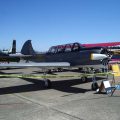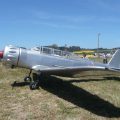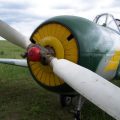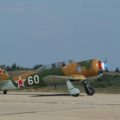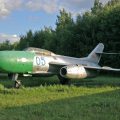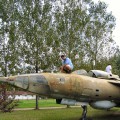
Yakovlev Yak-50 | |
|---|---|
| País | Unión Soviética |
| Tipo | Avión de entrenamiento/acrobático |
| Producido | 1975-1986 |
| Construido | 314 |
el Yakovlev Yak-50 (Russian: Яковлев Як-50) aerobatic aircraft is a single-seat all-metal low-wing monoplane with retractable main wheels and exposed tail wheel. The control surfaces are fabric-covered to save weight. The aircraft is not equipped with flaps. The supercharged engine may be the Vedeneyev M14P (standard production line version), M14PF or M14R, producing between 360 and 450 hp and driving the propeller via a reduction gearbox. The landing gear, brakes and engine starter are operated by compressed air. Replenished by an engine-driven compressor, the main and emergency air bottles are contained within the forward fuselage between the firewall and fuel tanks.
Fuente: Yakovlev Yak-50 en Wikipedia
| Yakovlev Yak-50 Paseo alrededor | |
|---|---|
| Fotógrafo | Vladimir Yakubov |
| Localización | Casa Abierta del Aeropuerto de Hayward |
| Fotos | 64 |
Ver también:
el Yakovlev Yak-50 es un avión acrobático monoplaza que fue desarrollado por el fabricante soviético Yakovlev en la década de 1970. Es un monoplano de ala baja con un fuselaje metálico y superficies de control cubiertas de tela. Tiene un tren de aterrizaje principal retráctil y una rueda de cola fija. El Yak-50 está propulsado por un motor de pistón radial que impulsa una hélice de dos palas. El motor puede ser el Vedeneyev M-14P, M-14PF o M-14R, produciendo entre 360 y 450 caballos de fuerza.
The Yak-50 was designed as a trainer and aerobatic aircraft for the DOSAAF, the Soviet paramilitary aviation organization. It first flew on 25 June 1975 and entered service in 1976. The Yak-50 proved to be a successful aerobatic aircraft, winning two world championships in 1976 and 1980. It also served as a military trainer for several countries, including Lithuania, Russia and Ukraine.
el Yak-50 has excellent handling characteristics and a high power-to-weight ratio, allowing it to perform complex maneuvers and unlimited aerobatics. However, it also has some drawbacks, such as high fuel consumption, limited range and endurance, and structural fatigue due to the high stresses imposed on the airframe. Some Yak-50s suffered from wing spar failures, resulting in fatal accidents. The Yak-50 was eventually replaced by more advanced aerobatic aircraft, such as the Yak-55 and the Su-26.
Today, only about 90 Yak-50s remain airworthy and are owned by private pilots and collectors in various countries. The Yak-50 is still regarded as one of the best aerobatic aircraft of its era and a classic example of Soviet aviation engineering.
Vistas : 2017



